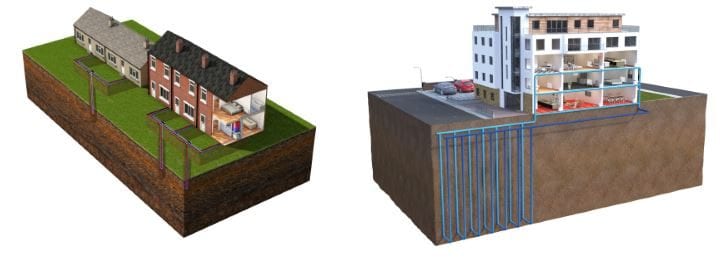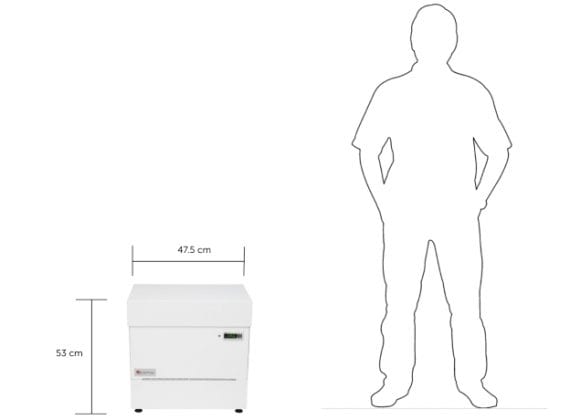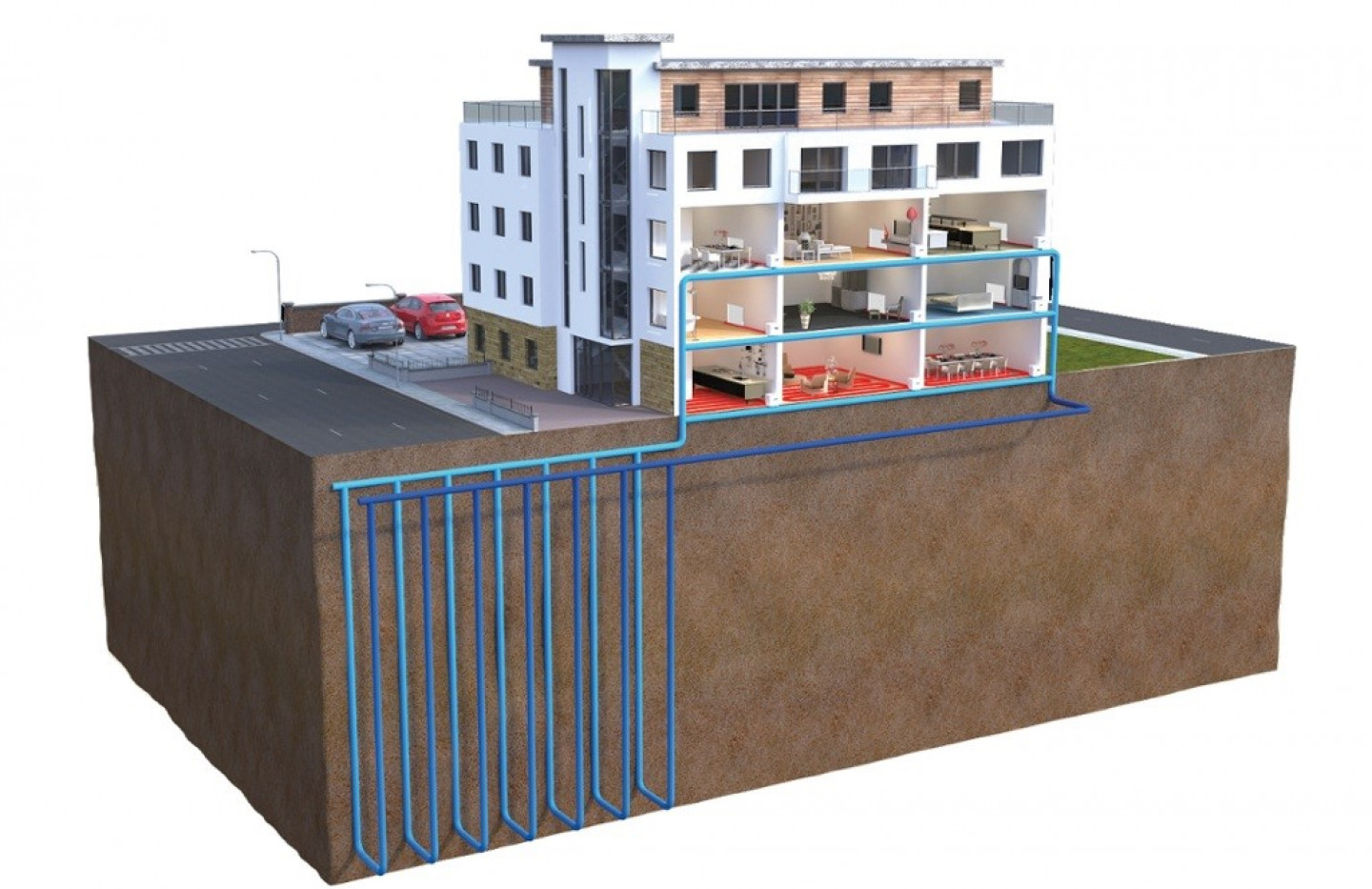Kensa’s Ambient Shared Ground Loop Arrays (SGLAs) are an award-winning and pioneering approach to District and Communal Heating without the drawbacks of traditional Heat Network systems.
The unique design allows property owners and developers of two or more dwellings to realise the full potential of ground source heat pumps and receive Non Domestic Renewable Heat Incentive (RHI) payments for both new builds and existing housing stock, attracting external funding opportunities for fully funded ground arrays and ultra-low cost heat pumps.

What are Ambient Shared Ground Loop Arrays?
Kensa’s Ambient Shared Ground Loop Arrays (SGLAs) are a 5th generation ultra-low temperature Heat Network for use with Kensa Shoebox ground source heat pumps or Evoheat pumps.
Mimicking a traditional gas framework, a series of ground arrays, typically boreholes, are linked together to form a shared ground loop array acting as a heat energy source to multiple properties (District Heating) or multiple occupancy buildings (Communal Heating).
The shared ground loop system transfers ambient temperature low grade heat energy from the ground (-5°C to 20°C) to individual Kensa ground source heat pumps located inside each individual dwelling.
Each Kensa ground source heat pump then upgrades the ground’s heat energy to provide independently controllable heat and hot water to the property.
Kensa Shoebox Heat Pump
Before the launch of Kensa’s famed Shoebox heat pump, multi-occupancy developments such as apartments and tower blocks, were unable to benefit from ground source heat pump technology due to sizing and specification issues.
Developed with Shared Ground Loop Arrays in mind, the unique, ultra-small and ultra-quiet Shoebox range of heat pumps from Kensa Heat Pumps are typically installed under the kitchen sink or in an airing cupboard, creating a significant opportunity for social housing providers and developers to introduce the most effective and efficient renewable heating technology in multi-occupancy dwellings.
EXPLORE THE SHOEBOX
Communal ground loops with individual heat pumps are the most economic solution of all (at approximately £500/yr) and are also compliant with London’s key objectives in terms of air quality and carbon emissions. They combine several advantages: they are very energy efficient and do not require dedicated heat metering and billing.Greater London Authority (GLA), ‘Low Carbon Heat: Heat Pumps in London’ (September 2018)
Shared Ground Loops Vs Heat Networks
| Shared Ground Loop Arrays | Traditional Heat Networks |
|---|---|
| + Ambient loop - no heat losses | - Heat loss through network |
| + No overheating (Read more) | - Overheating in risers & corridors |
| + Independent billing | - Requires split-billing |
| + Independent heat - freedom to switch suppliers | - Single heat energy provider |
| + Receives Non Domestic RHI (Read more) | - Complex funding claims |
| + Deemed heat for RHI - no heat meters | - Networked heat metering |
| + No plant room - individual heat pump per dwelling | - Large & unsightly central plant |
| + Lowest bills | - ESCO purchases energy |
| + No servicing & minimal maintenance | - Highly specialised servicing |
| + Robust and reliable | - Back up system required |
| + Carbon compliant (Read more) | |
| + No emissions (Read more) | |
| + Free passive cooling (Read more) | |
| + Flexible and scalable | |
| + Planning exempt |
Benefits: In Detail
Hover over the below interative image to find out more about the unique benefits of Shared Ground Loop Arrays from Kensa.

Decentralised Heat Networks
Connecting individual Kensa heat pumps installed within multiple dwellings (District or Communal) to a Shared Ground Loop Array circulating at a low temperature provides a unique and technically robust Heat Network, which in addition to qualifying for 20 years of income through the Non Domestic RHI, also offers significant operational benefits over traditional district Heat Networks.
The decentralised approach results in a more efficient system as there are no heat losses through the distribution pipework as the circulated heat through the Shared Ground Loop Array is at ambient temperature, with high-grade heat only generated at the point of use, and only when required; unlike traditional Heat Networks where heat is generated in a central plant and then circulated continually, thus leading to heat losses, and overheating in multiple occupancy buildings.
As such, with Kensa’s Shared Ground Loop Arrays there are no heat losses from the system to contribute to overheating in risers and corridors, a common issue with offices and apartment blocks. Furthermore, as the cold side infrastructure extends all of the way to the individual dwelling, it is easy to add passive cooling to the system.
Crucially, as each dwelling has its own ground source heat pump wired to its own electricity supply, the occupant is in full control of their heating, and billed independently; no tie-in’s to Heat Network contracts or issues of split billing, and complete freedom to switch energy supplier to ensure the best deal.
The Government recognises that GSHPs are likely to be a strategically important technology for decarbonising heat, and anticipates potential for significant growth in deployment of this technology through the period to 2050.
The Government is keen to support the deployment of GSHPs making use of shared ground loops. This route (shared ground loops) will improve investment confidence and ............. will also offer the greatest flexibility, encouraging a broad range of shared loop projects to come forward including new build and mixed use projects.Department for Business, Energy & Industrial Strategy, 'THE RENEWABLE HEAT INCENTIVE: A REFORMED SCHEME: Government response to consultation', (December 2016)
How It Works
In Theory
This Kensa animation depicts the key stages for the installation of Kensa Shoebox ground source heat pumps into individual flats in tower blocks, connected to ambient shared ground loop arrays (boreholes).
In Practice
This Kensa time lapse shows the drilling of 25 shared ground loop boreholes for Kensa Shoebox heat pumps in 49 bungalows owned by Stonewater Housing in Weobley (read thecase study here).
